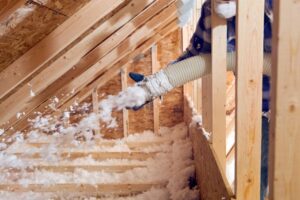Did you know that many homes, especially older homes, have never had their attics insulated? And even in homes that were properly insulated at one point, that insulation may have deteriorated with age, been damaged by humidity, or even been carried off by rodents to make nests. Some estimates suggest that up to 40% of a home’s energy loss happens through the attic.
As spring arrives and summer is not that far away anymore, think about all your lovely cool conditioned air. Do you want to let it escape through your attic? No, you want to keep it inside where it’ll keep you comfortable! And here’s another benefit of blown-in insulation: it can improve your indoor air quality, keeping the air you breathe cleaner. How? We’ll tell you.
What Is Blown-In Insulation?
You may think of insulation as a roll of a thick, fluffy substance that unrolls into a single layer in a strip perhaps two feet wide and a few inches thick. This is called batting or batt insulation. In contrast, blown-in insulation is comprised of separate fibers. It is “stuff” that can conform to any shape, rather than a “thing” that is already a specific shape. The fibers can be made of fiberglass, mineral wool, cotton, or even cellulose from recycled newspapers.
How Is Blown-In Insulation Installed?
The fibers come compressed in a block. Two installers work together to get the job done. One loads the blocks of insulation into a specialized machine that separates the fibers and blows them through a wide hose. The other installer guides the end of the hose, directing the spray of fibers to fill all the nooks and crannies to ensure an even depth of insulation. For an average-sized house, the attic can be completely insulated in just a few hours, much less time than it would take for two installers to properly insulate the same space with batting.
How Does Blown-In Insulation Improve Indoor Air Quality?
An uninsulated or poorly-insulated house is drafty. This means that hot, humid air in the summer and chilly breezes in the winter get into the house. The impact on your heating and cooling bills might be obvious. But have you ever stopped to think about what those drafts and breezes might be bringing with them into your home?
Ordinary dust and dirt, contaminants like agricultural chemicals or vehicle exhaust, and allergens such as mold spores and pollen can come in just as easily as the drafts, carried on the air. But with blown-in insulation in Melbourne, FL, every little crevice can be sealed up.
The free-form nature of the insulation means that all the tricky little spaces such as tight corners and around piping or ductwork, are easy to completely fill. All those particles can be kept out.
The ability to better control humidity in your home because of this effective insulation will improve your air quality. First, air with the correct levels of humidity is more comfortable to breathe. And second, too much moisture in the air leads to mold growth and breathing mold spores can have serious health consequences.
If you’d like to learn more about your home’s existing insulation and what could be done to improve it, we’d love to hear from you.
Contact Climate Experts Air, Plumbing & Electric today. We’re your indoor weathermen!



